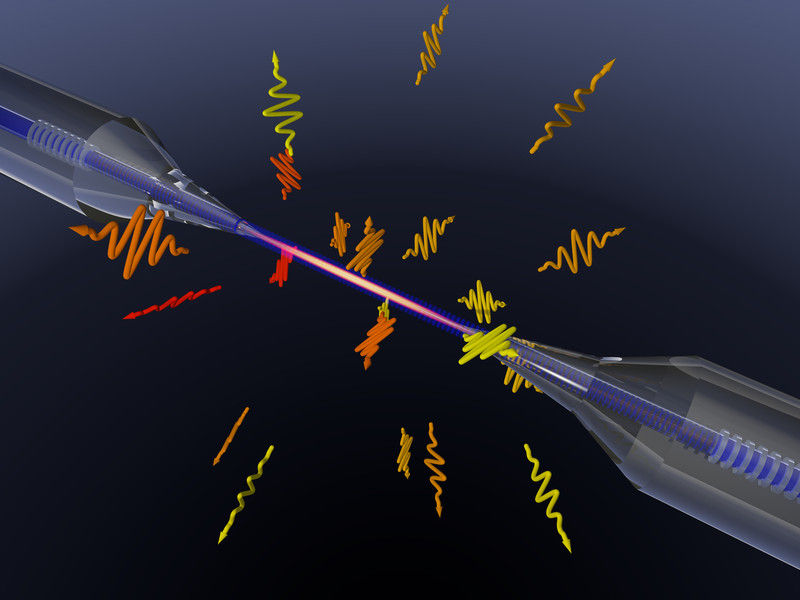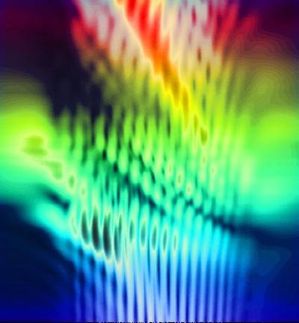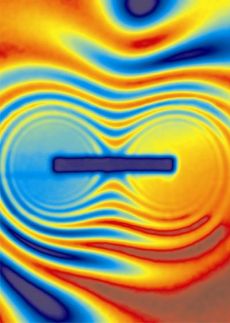Heat radiation of small objects: beyond Planck’s equations
Objects that are smaller than the wavelength of thermal radiation cannot radiate heat efficiently. A generalized theory of thermal radiation has now been experimentally confirmed at the level of a single object at the Vienna University of Technology.

An ultra-thin glass fiber emits light of different wavelengths. Theories going beyond Planck's law can describe this emission very accurately.
TU Wien
All the objects around us emit thermal radiation. Usually, this radiation can be described very accurately using Planck’s law. If, however, the radiating object is smaller than the thermal wavelength, it behaves according to different rules and cannot emit the energy efficiently. This has now been confirmed by a team of researchers at the Vienna University of Technology. These findings are important for heat management of nano-devices and also for the science of aerosols - microparticles suspended in air, which influence the climate.
Planck’s law
In 1900, the Physicist Max Planck came up with a formula describing the heat radiation of bodies as a function of their temperature. In doing so, he laid down the groundwork for quantum physics. His theory describes the radiation of a wide variety of objects, such as the light emitted by stars, the color of a glowing poker stick, or invisible heat radiation that can be recorded with infrared cameras. But while his theory can be applied to many different systems, Planck himself already knew that it is bound to fail and has to be replaced by a more general theory when very small objects are involved.
This has now been investigated at the Vienna University of Technology by Christian Wuttke and Arno Rauschenbeutel (Vienna Center for Quantum Science and Technology, Institute for Atomic and Subatomic Physics, Vienna University of Technology) by studying the heat radiation of ultra-thin optical fibers.
Absorbing and emitting radiation
Max Planck considered bodies which absorb all radiation. Due to the conservation of of energy, radiation has to be re-emitted by the surface. The body’s temperature determines at which wavelengths the heat radiation is emitted, and this temperature-dependent wavelength distribution can be predicted with great accuracy using Planck’s equations.
“However, things change if the object is smaller than the typical length over which the radiation is absorbed”, says Arno Rauschenbeutel. “In that case, the body cannot fully absorb the incoming radiation, part of it can pass through.” As a result, the thermal radiation of the body is altered and does not obey Planck’s law any more.
Fluctuational electrodynamics
Christian Wuttke and Arno Rauschenbeutel sent light through ultra-thin optical fibers with a diameter of only 500 nanometers. They measured the amount of optical energy which was converted into heat and subsequently radiated away into the environment. “We could show that the fibers take much longer to reach their equilibrium temperature than a simple application of Planck’s law would suggest”, says Arno Rauschenbeutel. “However, our findings are in perfect agreement with the more general theory of fluctuational electrodynamics, which allows one to take the geometry and the size of the body into account.”
Data transfer and soot particles
Arno Rauschenbeutel’s research group is also using ultra-thin optical fibers to transmit quantum information. In this context, a good understanding of the fibers’ thermal behavior is very important. A slower cooling process and a less effective heat transport entails a higher risk of the fibers melting and burning out when data is sent through.
More general theories of heat radiation beyond Planck’s equations also play an important role in aerosol physics, which deals with tiny particles in the atmosphere. “The thermal radiation of a lump of coal can be described perfectly well by Planck’s law, but the behavior of soot particles in the atmosphere can only be described with a more general theory, which we could now further confirm in our experiment”, says Arno Rauschenbeutel.
Most read news
Organizations
Other news from the department science

Get the chemical industry in your inbox
By submitting this form you agree that LUMITOS AG will send you the newsletter(s) selected above by email. Your data will not be passed on to third parties. Your data will be stored and processed in accordance with our data protection regulations. LUMITOS may contact you by email for the purpose of advertising or market and opinion surveys. You can revoke your consent at any time without giving reasons to LUMITOS AG, Ernst-Augustin-Str. 2, 12489 Berlin, Germany or by e-mail at revoke@lumitos.com with effect for the future. In addition, each email contains a link to unsubscribe from the corresponding newsletter.





























































